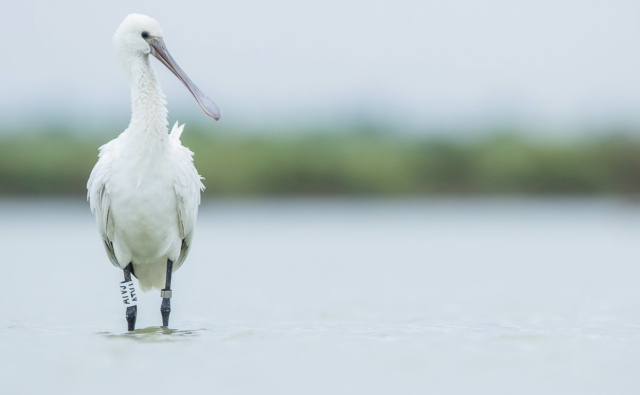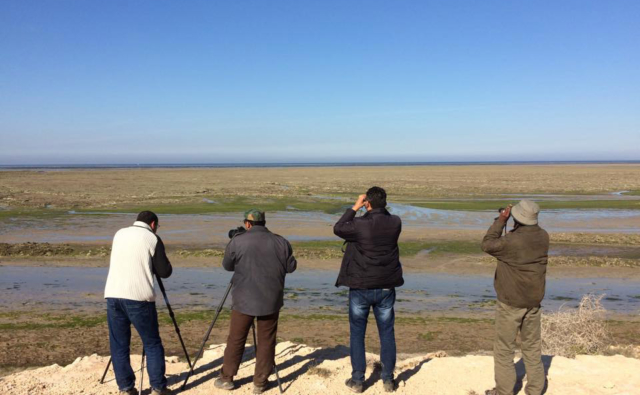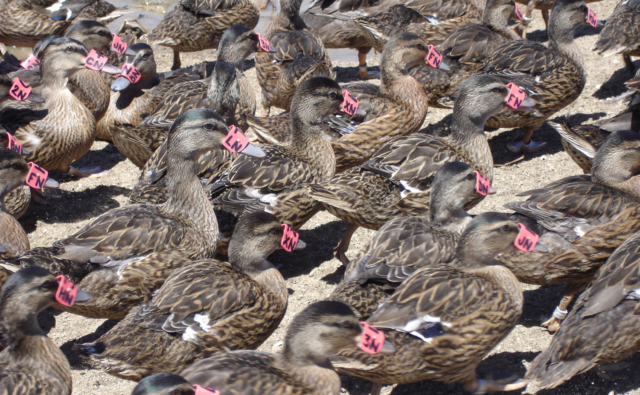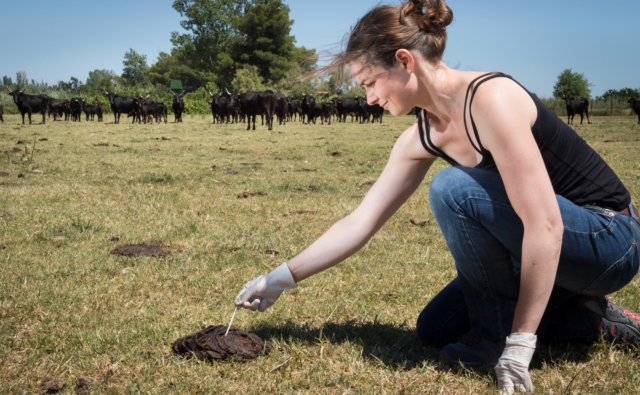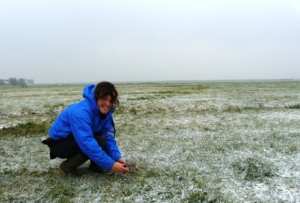
Lucie Schmaltz is National Coordinator of the International Waterbird Census at the French society for the protection of birds/Birdlife France.
She answers questions from the Tour du Valat about the ducks, geese, and swans (Anatidae) in the Camargue.
1) What is the importance of the Camargue as a wetland for waterbirds on a national scale?
The Camargue has been a pioneer in the development of counting waterbirds in France. In 1955, a decade before the start of coordinated counts of wintering Anatidae and Coots in Europe, Luc Hoffmann directed the first complete counting campaign for waterbirds in the Camargue, one year after the creation of the Tour du Valat biological station and research centre. It is therefore no coincidence that, in 1986, the Camargue became the first Wetland of International Importance to be designated in France under the Ramsar Convention. In addition, the Camargue ranks first among the sites of importance in France in the Wetlands International census.
One of the Camargue’s strongest features is that it is located in an area of overlapping biogeographic populations that use Mediterranean/Black Sea and West Atlantic flyways. With an average of nearly 181,000 waterbirds counted annually over the past ten years, it contributes 6% of the national average total of almost 2.8 million waterbirds in mid-January. According to the latest assessment in mid-January 2019, the Camargue is the leading French wintering site for 14 waterbird species, and especially for the Anatidae for which it contributes almost 53% of the national population in mid-January of Red-crested Pochards, 39% of Gadwell, and about 25% of wintering Eurasian Wigeon, Northern Shoveler and Green-winged Teal. The site also hosts the largest French wintering contingents of Greater Flamingo, Glossy Ibis, and Common Coot. Its importance for the Common Crane and the Eurasian Spoonbill is continuing to increase.
The Camargue meets the criteria of international importance for a total of 17 species, which is to say that it hosts more than 1% of the estimated biogeographic populations of the following birds: Green-winged Teal, Common Coot, Greater Flamingo, Mallard, Common Crane, Dunlin, Gadwell, Eurasian Wigeon, Northern Shoveler, Common Shelduck, Red-crested Pochard, Mute Swan, Pied Avocet, Little Egret, Glossy Ibis, Common Ringed Plover and Eurasian Spoonbill. By comparison, the sites of international importance on the Atlantic coast meet the criteria for 1% of the biogeographical population of eight species on average (Arcachon catchment basin, Guérande peninsula, Aiguillon Bay and the Moëze-Oléron Nature Reserve).
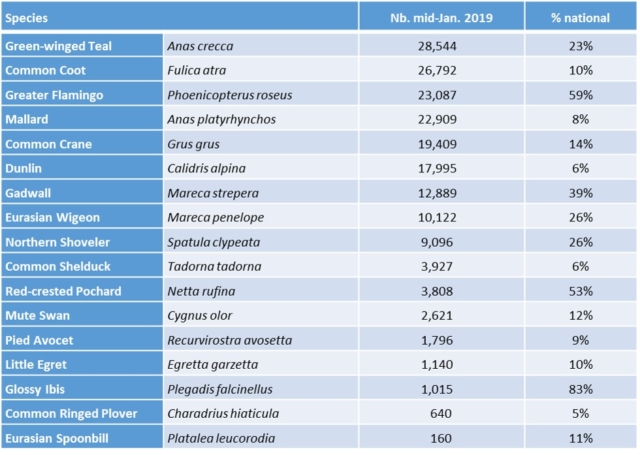
2) What are the differences and the similarities in the trends of populations between the Camargue and the other sites in France and Europe?
Overall, the major waterbird number trends in mid-January follow the flyway population trends indicated in the last Report on the conservation status of migratory waterbirds in the African-Eurasian Waterbird Agreement area. This is also true in the Camargue, where there is strong growth in the numbers of Great Egret, White Stork, Eurasian Spoonbill, and Common Crane. In 1993, only 60 Great Egrets were reported in mid-January, whereas more than 700 individuals were reported in 2019. The same goes for the Eurasian Spoonbill: one bird was reported in 2000, compared to 160 in 2019. The Camargue also became the second most important French wintering site of the Common Crane, which was extremely rare, if not nearly absent from Camargue in the early 2000s, because it was mainly confined to the wintering sites of Lorraine, Champagne and the Landes de Gascogne, while now about 15-20,000 cranes have been counted over the last three years. The sharp increase in these large wading birds surveyed in mid-January in France and in Western Europe is concomitant with the growth of their breeding populations and distribution areas. The milder winter climate conditions, cessation of persecution and the establishment of regulatory protection in the 1970s combined with strong conservation measures are all factors that have certainly played a role in the growth of these populations in Western Europe. Finally, the Mute Swan is also experiencing very strong growth in the Camargue, as is the overall trend observed for this species.
As for declining populations, which are also observed, Common Pochard and Tufted Duck communities are shrinking in the Camargue as elsewhere. Over the past ten years, the number of Greylag Goose counted in mid-January in the Camargue seems to have declined, despite the favourable status of the central European population.
It is difficult to draw conclusions from these divergences, because the censusing conditions must be taken into account in the Camargue, where making an inventory is difficult due to the scale of this mega-site and its significant interannual variations. David de Vallecillo‘s thesis, part of which is still in progress, will certainly improve our understanding of these phenomena. His research focuses on the influence of counting methods (air counting vs. ground counting), and of the observer, on the validity of the census and our ability to detect population trends. Finally, little difference was observed between the trends in the numbers of waterbirds reported in the Camargue in mid-January and the national and flyway population trends. However, the strong growth of the waterbird communities in the Camargue, as well as at the national and flyway levels, are probably linked to the overall improvement in the quality of French wintering sites since the monitoring began. Since then, trends in the Camargue and in France have rather accurately reflected the population trends in global flyways.
3) What are the differences between the situation in the Mediterranean and the Atlantic?
Knowledge of waterbird populations has improved significantly since the beginning of the Wetlands International censuses and the related initiatives to develop the carrying capacity of the Eastern Atlantic and Mediterranean-Black Sea biogeographic regions. The overall trends in waterbird population numbers in these two flyways are almost identical in terms of the number of declining, stable or increasing species: 40% of the populations seem to be in decline compared to 60% increasing or stable. In France, this ratio is identical when we look at the short-term trends of the approximately 70 species that were monitored in mid-January. The strong long-term growth of waterbirds is more marked (70% of species have been increasing since 1980), which suggests that the national situation is more favourable than in global flyways. In particular, coastal shorebirds have increased considerably since the monitoring began and contribute to this overall increase in the same way as the large wading birds we talked about earlier.
The population trends observed on the Atlantic and Mediterranean coasts correspond broadly to this national pattern without a significant difference, except for the Anatidae, which are increasing more on the Mediterranean coast than on the Atlantic coast, in particular in the Bay of Biscay. For shorebirds and other species of waterbirds (including Ardeidae, Ibis, and Spoonbills), the increase is widespread on the three coasts, with the exception of three species of shorebirds in decline in the English Channel – the Pied Avocet is declining on the main site of the Seine estuary since the changes to the estuary and Port 2000; Dunlin and Bar-tailed Godwit are also declining across the Channel.
Overall, the French Atlantic coast has seen a considerable increase in the numbers of coastal shorebirds in connection with the improved carrying capacity of the sites and the creation of large nature reserves in estuarine bays. Significantly, certain populations, such as the Sanderling and the Black-tailed Godwit, have grown considerably.
Comparison is difficult on the Mediterranean side: shorebirds are less numerous and are mainly represented by three species – the Dunlin, Little Stint, and Pied Avocet, all of which show significant increases. The other less abundant species, such as the Grey Plover, Eurasian Curlew, and Common Redshank, are also all increasing in the Mediterranean. Shorebirds respond particularly well to the protection of sites and to the dedicated management measures in most Mediterranean lagoons, which include the establishment of quiet zones, and water level management. As for the Anatidae and Coot, the trends show widespread increases, more significant in the Mediterranean than in the Bay of Biscay. The numbers of Eurasian Wigeon and Northern Pintail counted in mid-January are declining in the Bay of Biscay while remaining stable or even increasing moderately in the Mediterranean. The numbers of Green-winged Teal and Common Coot are increasing in the Mediterranean and are stable in the Bay of Biscay. Certain species, such as the Mallard, Common Shelduck, and Mute Swan, are also increasing significantly more in the Mediterranean than in the Bay of Biscay. The carrying capacity of large Mediterranean bodies of water and lagoons, where management actions target mainly the Anatidae, could be greater than in sites along the Bay of Biscay, which contain large intertidal areas or estuarine bays that are ultimately more suitable for large concentrations of Charadriiformes.
The coasts of the English Channel-North Sea and the Bay of Biscay have also experienced very significant declines of species that are rarely or not found in the Mediterranean, such as the Common Eider, Greater Scaup, and Common Goldeneye. The severe decline of the Tufted Duck, formerly an abundant species on the Mediterranean coast, has also been observed in the Bay of Biscay, where this species is in moderate decline.
It is difficult to interpret the few differences that exist between the Mediterranean coasts and the Atlantic coasts. Overall, the situation of waterbirds in France, the Atlantic, and the Mediterranean has greatly improved, and the declines observed today seem to reflect population trends more than trends specific to our country. In this context, the major intergovernmental conventions such as AEWA, and Ramsar, and initiatives developing at the flyway scale like the Mediterranean Waterbird Network and Wadden Sea Flyway Initiative are essential tools for working to protect wetlands and waterbird populations on the global scale of their ranges.
Contact: Lucie Schmaltz (email)
